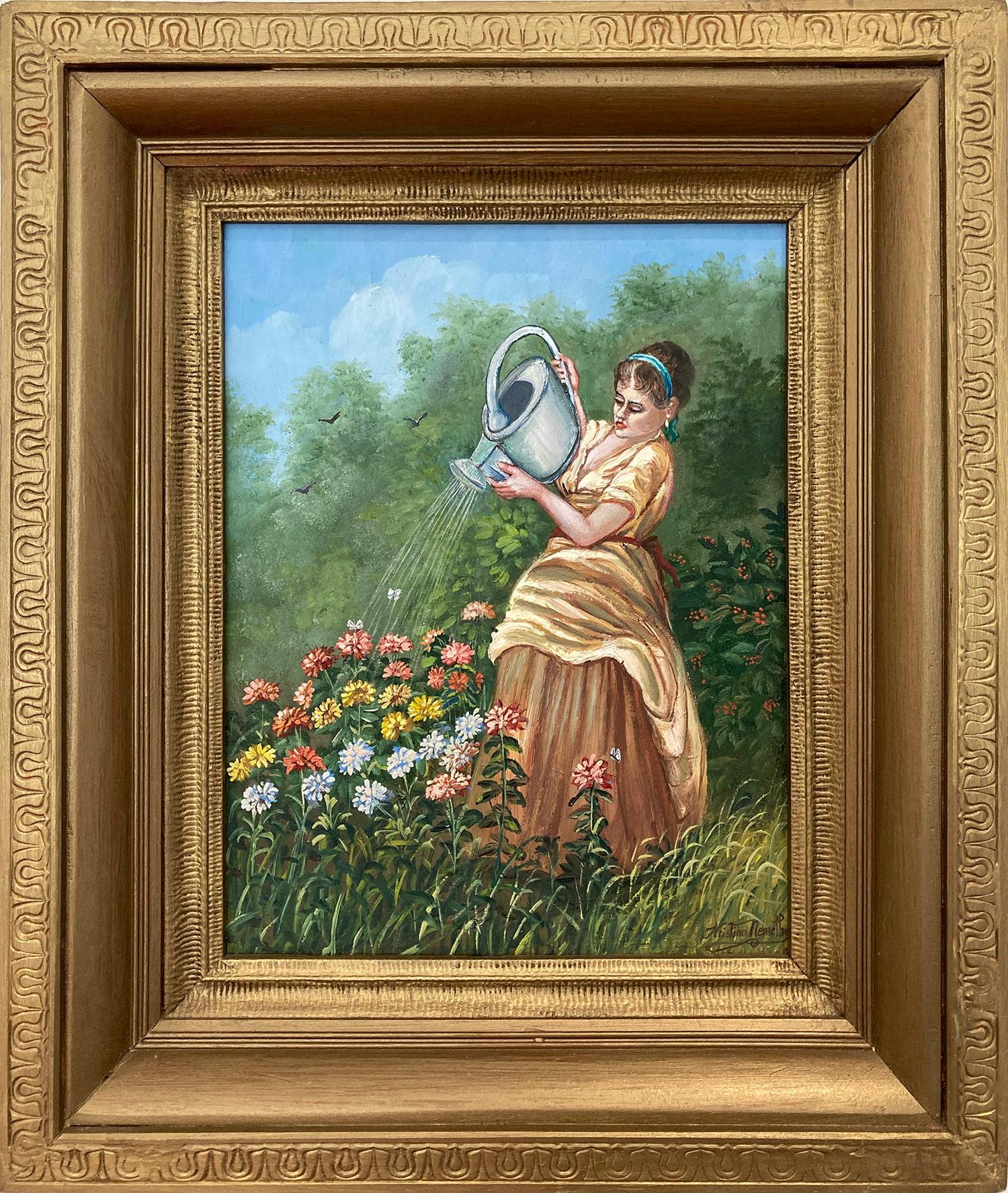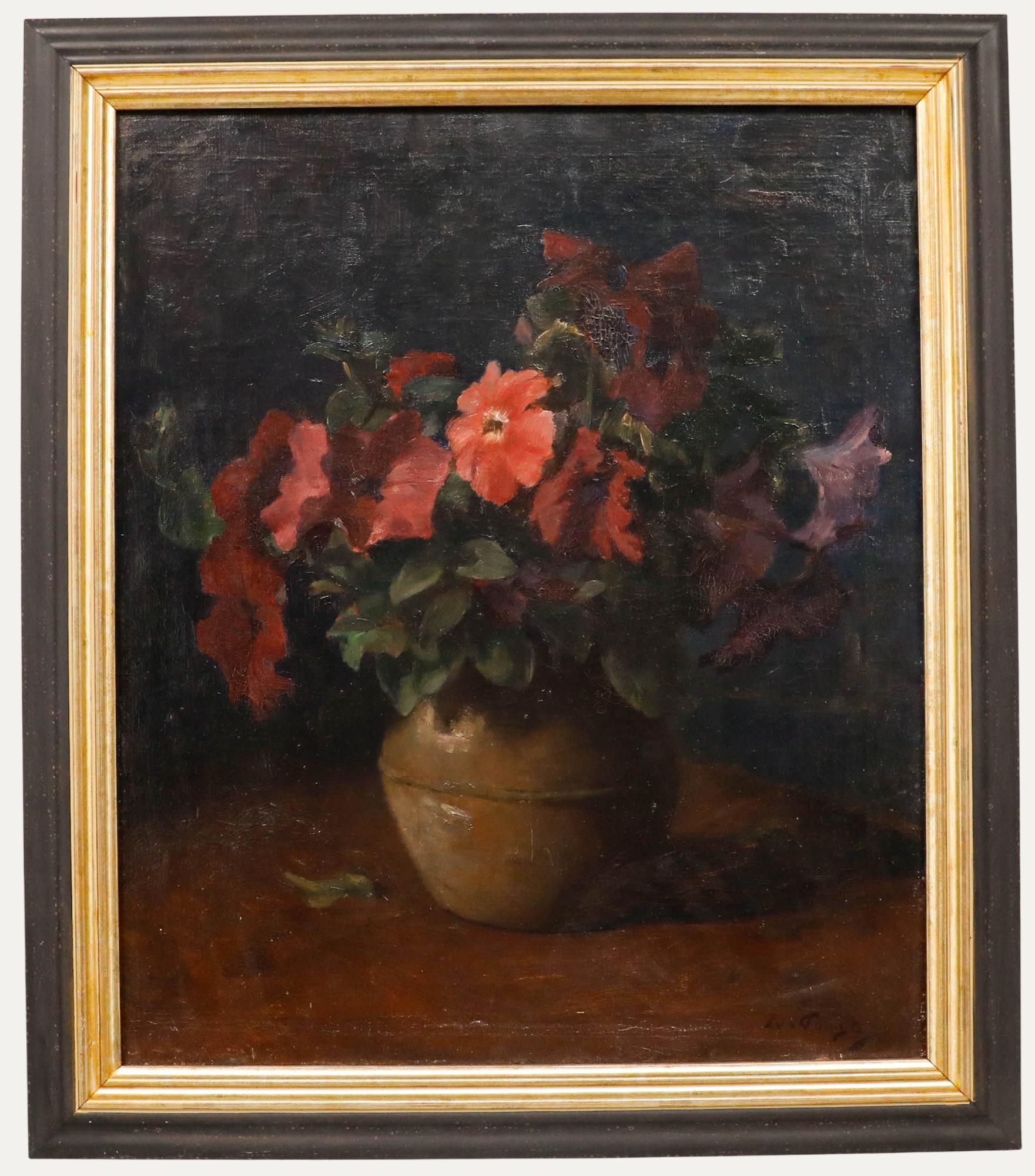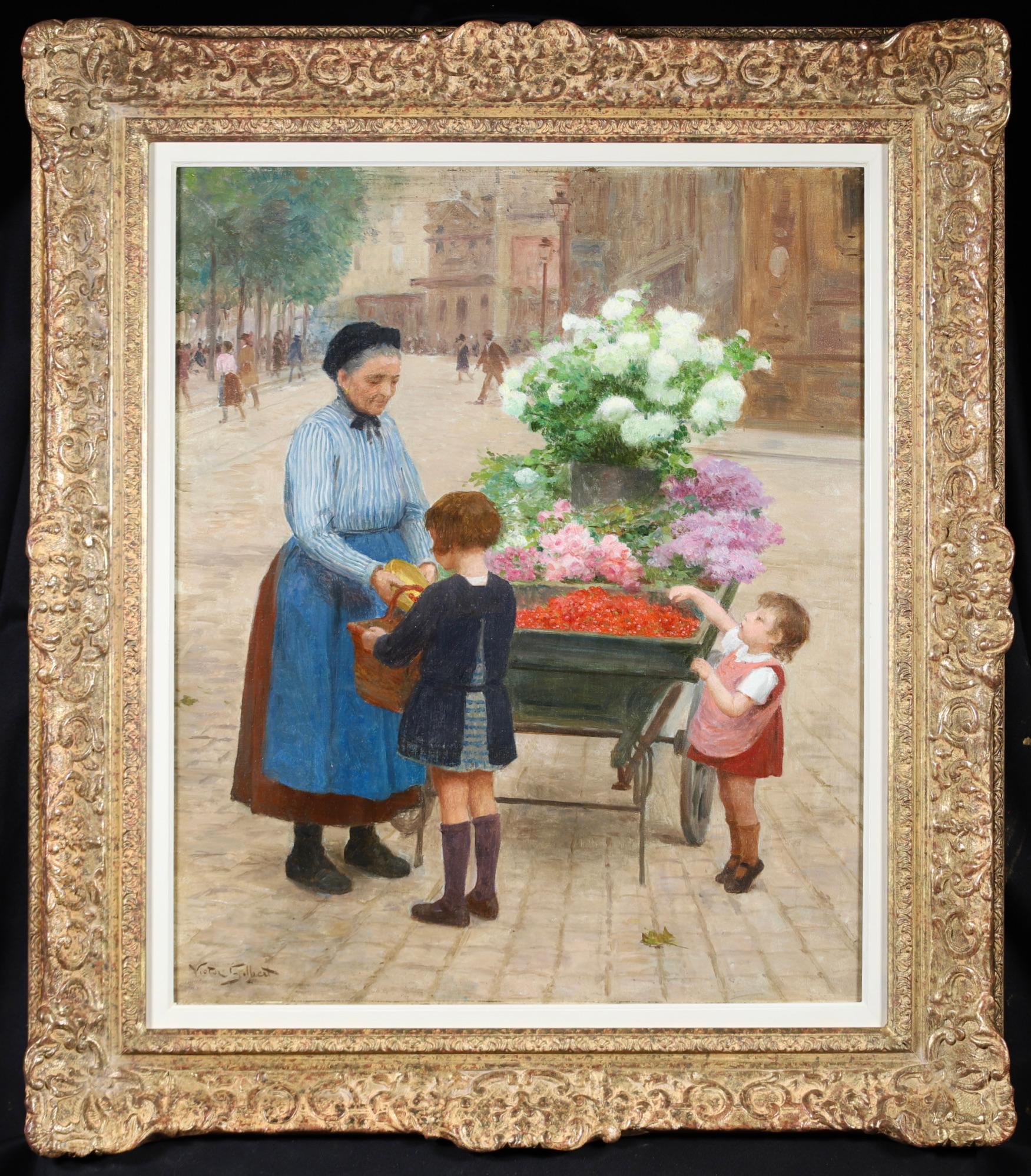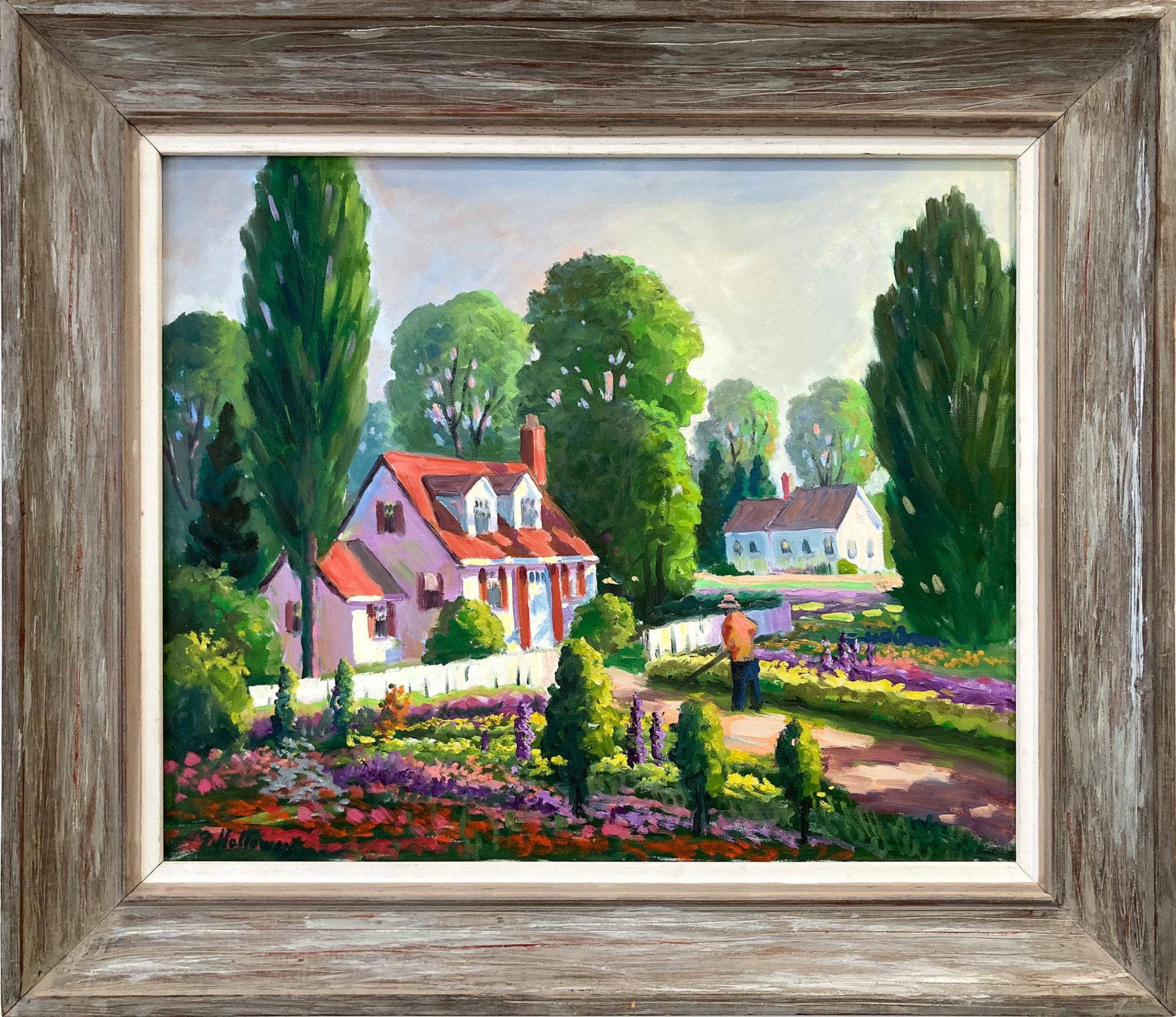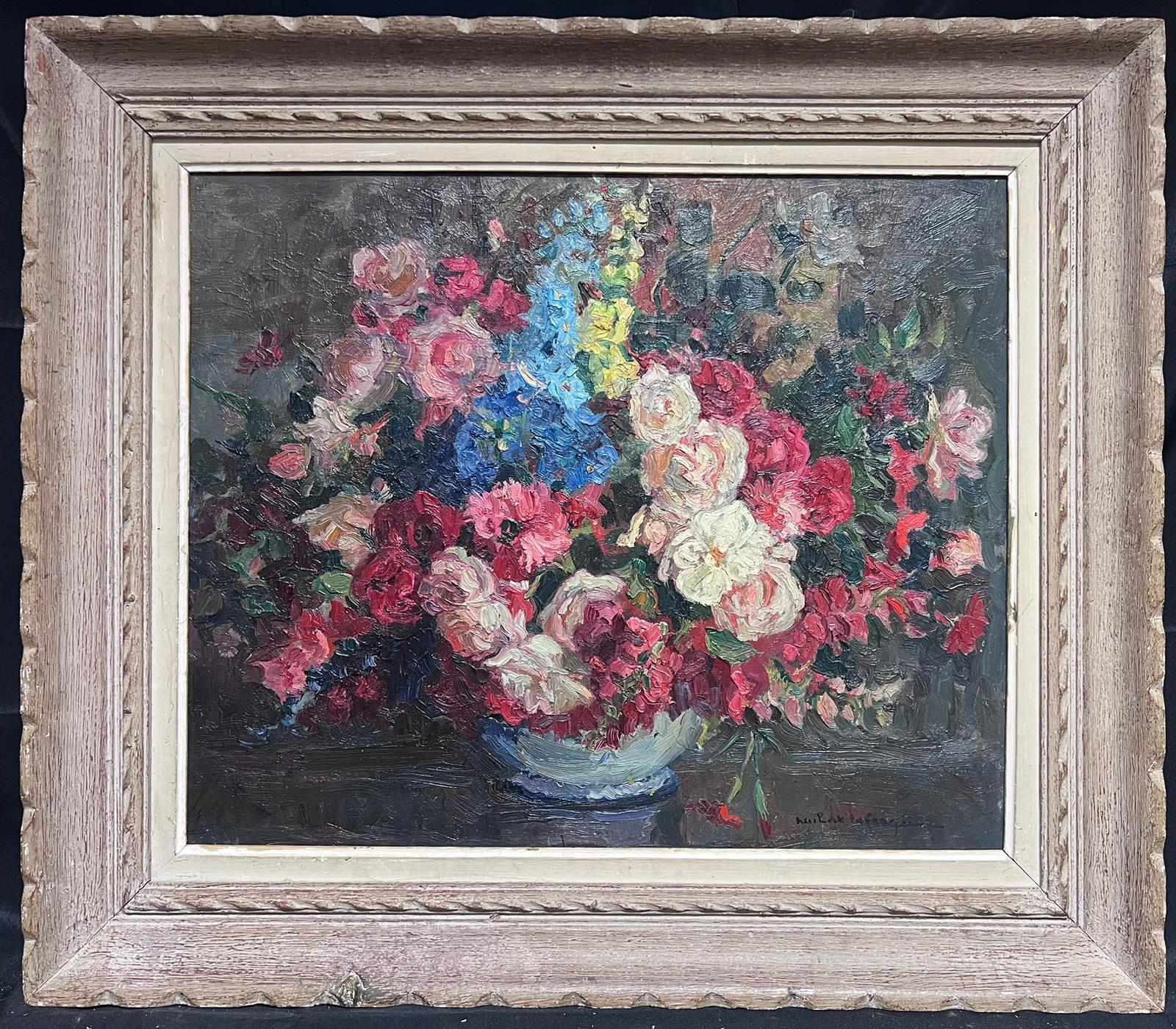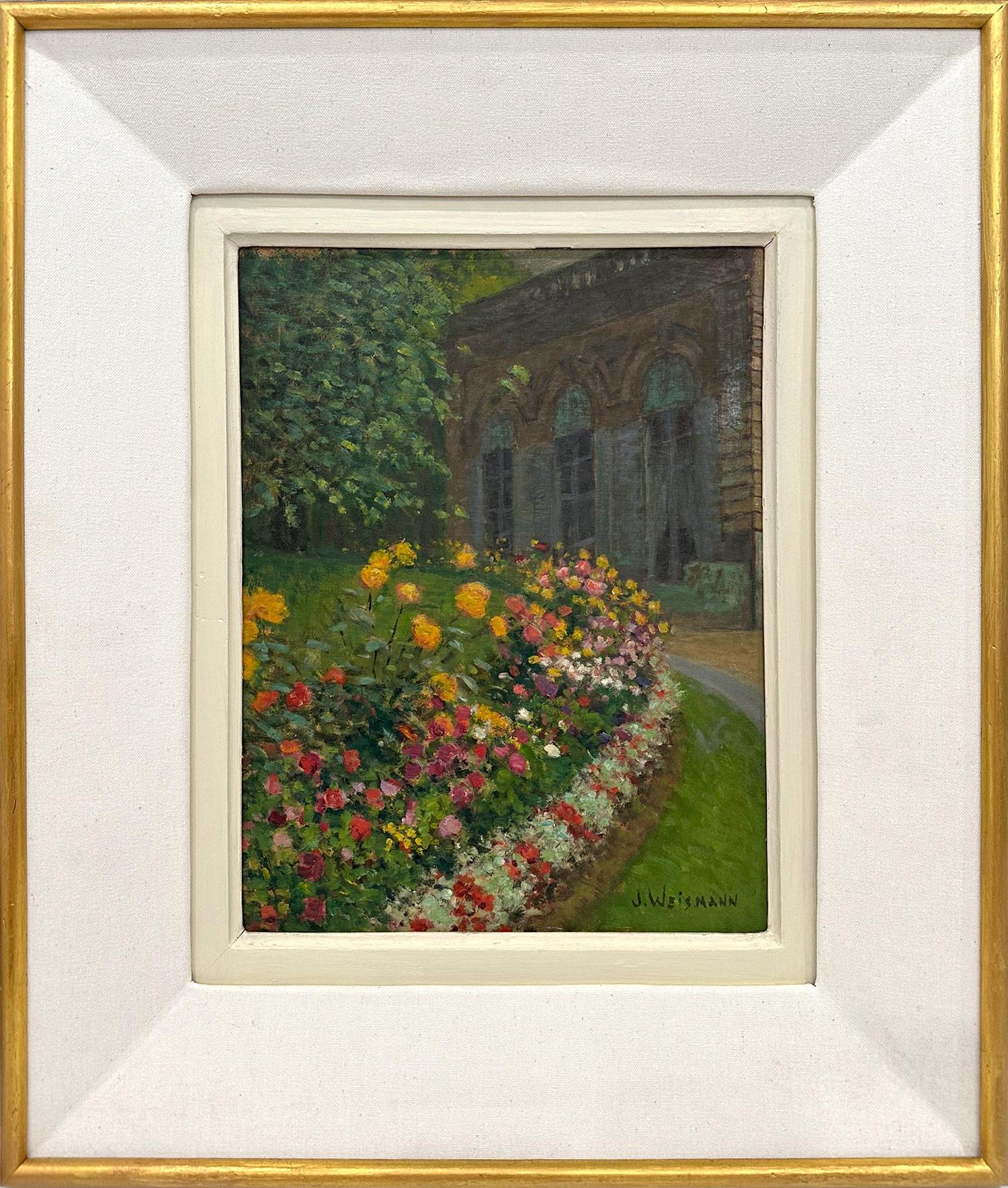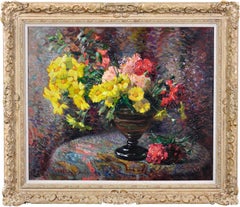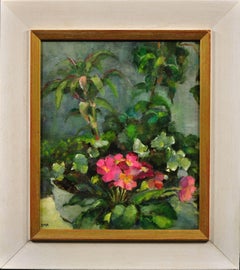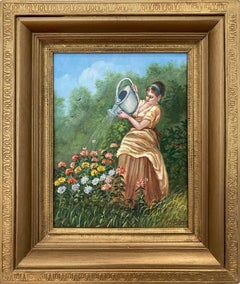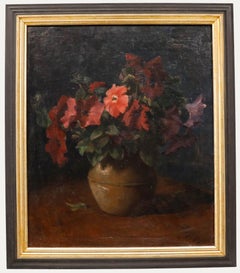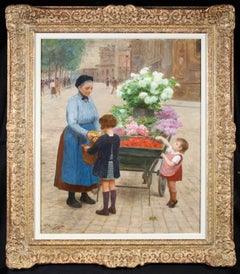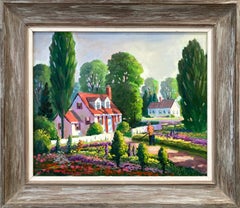Items Similar to Framed Belgian Luminist Oil Painting Le Petit Jardinier With Potted Geraniums
Want more images or videos?
Request additional images or videos from the seller
1 of 23
Francois GailliardFramed Belgian Luminist Oil Painting Le Petit Jardinier With Potted Geraniums1887
1887
$27,529.52
£19,985
€23,558.69
CA$37,857.22
A$42,100.89
CHF 22,037.88
MX$513,579.69
NOK 276,913.92
SEK 260,473.29
DKK 175,850.31
About the Item
François Désiré Antoine Gailliard.
Belgian ( b.1861 – d.1932 ).
Le Petit Jardinier, 1887.
Oil On Canvas.
Signed & Dated Lower Right.
Image size 36.6 inches x 28.5 inches ( 93cm x 72.5cm ).
Frame size 41.7 inches x 33.5 inches ( 106cm x 85cm ).
Available for sale; this original oil painting is by the Belgian luminist artist François Gailliard and is dated 1887.
The canvas and the painted surface have benefitted from cleaning, restoration and conservation, which was performed on our instruction, supervision and approval.
The painting is presented and supplied in its original frame. The frame has been restored and reinforced with supporting brackets along with new replacement hanging fittings.
This antique painting is now in very good condition. It wants for nothing and is supplied ready to hang and display.
The painting is signed and dated lower right.
The renowned Belgian luminist painter, François Désiré Antoine Gailliard (also known as Frans or Franz Gailliard) was born in November 1861, in Brussels, Belgium. He was the son of Désiré Gailliard, a baker, and Anne Hubert. He grew up during a period when the country’s artistic landscape was flourishing. Raised in an atmosphere that encouraged artistic expression, Gailliard showed an early talent for drawing and painting. He pursued formal training at the Académie Royale des Beaux-Arts in Brussels, one of Belgium’s most prestigious art institutions. There, he studied under influential artists and developed the foundational skills that would shape his career.
Gailliard initially joined the studio of Jean-François Portaels, then went on to study with Jules Hoeterickx, François Bossuet, and James Ensor. He also worked alongside Fernand Khnopt and became friends with James Abbott McNeill Whistler, the American artist, who he met in 1887 during stays in Berlin and Paris. He became part of the artistic and intellectual circles of Belgium, and other close friends included artists such as Alfred Stevens, Jean-Louis Forain and Félicien Rops. Finally, he joined the studio of Jean-Léon Gérôme in Paris.
The academic environment in Brussels exposed Gailliard to various artistic traditions, but his work reflected an interest in pushing beyond academic conventions. Gailliard was particularly drawn to the evolving styles of the time, especially Realism and early explorations of Impressionism and Luminism, which would later define his signature style.
Gailliard’s early work showed influences from the Barbizon School and other European Realists, focusing on meticulous, lifelike representations of nature, figures, and everyday scenes. Like many artists of his generation, he was deeply impacted by the works of French artists such as Jean-François Millet and Camille Corot, who emphasized the beauty in the ordinary and the rural. This focus on realism, combined with a sensitivity to light and atmosphere, became a defining feature of Gailliard’s work.
However, Gailliard also admired Impressionism and its experimental use of colour and light. By the late 19th century, the work of French Impressionists like Claude Monet and Pierre-Auguste Renoir had gained international attention, and Belgian artists, including Gailliard, were beginning to incorporate these new approaches into their own work. His art became a fusion of detailed realism and a growing interest in capturing fleeting moments, light, and atmosphere—characteristics that placed him in alignment with Belgium’s Luminism movement.
Gailliard’s paintings from this period are characterized by their use of light and their focus on everyday scenes, especially those connected to nature and the rural life of Belgium. While he was not a strict follower of Impressionist techniques, his work often employed similar methods, particularly the soft, diffused use of colour to create atmosphere. “Le Petit Jardinier” (1887), is one of his most notable works and exemplifies his ability to render both figures and nature with careful attention to light.
Gailliard’s paintings were usually large canvases presenting genre scenes, portraits, nudes and landscapes. His works often highlighted the beauty in the ordinary and displayed a sense of quiet dignity and respect for his subjects. He also produced news cartoons, presented in French, Belgian and English weekly newspapers such as Le patriote illustré, Le petit bleu, and the London Illustrated News.
Gailliard’s work was regularly exhibited both in Belgium and abroad. He presented his first painting at the 1881 Brussels Salon, then from 1882 to 1891 exhibited at the Salon des Artistes Français de Paris. He also exhibited in Berlin, and participated in major exhibitions, including those organized by influential art societies in Belgium such as Les XX and La Libre Esthétique, both known for promoting avant-garde art. Although Gailliard was not a founding member of these groups, his participation in their exhibitions placed him alongside other significant artists of his time, and he gained a reputation for his refined style and technical mastery. In 1897 he painted a portrait of King Chulalongkorn of Siam during his official visit to Belgium.
Gailliard married Julie Constantine Maus in Brussels in 1898. They had a son, Jean-Jacques Gailliard, who also became an artist, designer and engraver.
As Gailliard matured as an artist, his style remained rooted in realism and Luminism, though he also incorporated elements of Symbolism and Romanticism. His later works showed a deepening appreciation for mood and emotion, with a focus on portraits, landscapes, and scenes that often carried a sense of introspection. His paintings evoke a sense of calm and reflection, with light used not just to illuminate but to convey a deeper emotional or symbolic meaning.
Gailliard went on to become the director of the Academy of Fine Arts of Saint Gilles, where, through the later efforts of his son, his reputation lives on.
François Gailliard died in 1932 in Saint-Gilles, Brussels, where a street was named after him. He left behind a body of work that, while perhaps overshadowed by more radical movements of the time, remained respected for its craftsmanship and its commitment to realism and light. In the decades following his death, his work has been rediscovered and appreciated for its role in bridging the gap between Realism and the evolving movements of Impressionism and Luminism in Belgium. In 1957 he was given a retrospective tribute exhibition in the City Hall of Saint Gilles, organised by the Group d’Art Saint Gillois.
Today, Gailliard’s paintings are celebrated for their quiet elegance, their masterful treatment of light, and their sensitive portrayal of everyday life. His work continues to be exhibited in Belgian art institutions, and he is regarded as one of the key figures of late 19th and early 20th century Belgian art.
© Big Sky Fine Art
“Le Petit Jardinier” (1887) by François Gailliard (also known as Franz or Frans Gailliard) is a captivating and significant oil on canvas painting, signed and dated by the artist in the lower right corner.
In this evocative piece, a young boy, dressed in a blue apron over a striped shirt, stands confidently against a textured background of warm, earthy tones. His gaze is calm and proud. He holds a red geranium plant in a terracotta plant pot in his left hand, its delicate bloom standing out vividly against the darker tones of his attire. The red geranium, a recurring symbol in art for resilience and endurance, here becomes a focal point that further enhances the painting’s depth of meaning. In his right hand, he carries a battered wooden gardening trug.
The composition beautifully balances light and shadow, with the soft light illuminating the boy’s face and highlighting the red geranium and the vibrant green foliage. The repeated use of square ended brushstrokes gives the work a very modern feel, despite it being nearly 140 years old.
This painting holds historical significance as it was likely produced specifically as a tribute to the painting “Le Vieux Jardinier”, produced a year earlier by the leading Belgian artist, Emile Claus. Emile Claus was a leading figure in the Luminism movement and a few years older than Galliard. He would have been 39 when he painted “Le Vieux Jardinier”; Galliard would have been 26 when he painted “Le Petit Jardinier”. There is an intergenerational dialogue between the two works.
The two paintings share a theme and strong visual links: firstly, the gardener, one old, the other a young boy. This contrast between youth and age is a well-established artistic motif that often serves to explore different stages of life. Claus’s depiction of an older gardener and Gailliard’s representation of a young one can be seen as complementary—two sides of the same coin. Secondly, the blue apron: Clothing and tools often serve as symbols of profession and identity in artwork, and by having both gardeners wear the same attire, Gailliard may have been emphasizing their shared roles despite the age difference. Thirdly, the geranium: The potted red geranium held in the left hand of both figures is another strong connection between the two works. The repetition of this specific flower may symbolize continuity in the cycle of life or the nurturing aspect of gardening, which can be passed from one generation to the next. It’s unlikely this is coincidental, especially given how closely the other elements mirror each other.
The artists were from a shared artistic movement and influenced by similar developments, although it is not thought that they ever directly collaborated. Both artists were active in Belgium’s dynamic art scene, and they exhibited in many of the same galleries and artistic circles. Though Gailliard was younger, he came of age during the height of Claus’s career, and it’s highly likely that Gailliard was influenced by Claus’s explorations of light and colour.
The fact that Gailliard painted “Le Petit Jardinier” only a year after Claus’s “Le Vieux Jardinier” is particularly suggestive. Gailliard was likely familiar with Claus’s work, given Claus’s prominence in the Belgian art scene and his influence within the Luminist movement. The close timeline hints that Gailliard may have consciously crafted his painting as a variation or response to Claus’s work.
It was not uncommon for artists to create pieces in homage to or inspired by the work of their contemporaries, especially when they admired or were influenced by them. Gailliard’s painting could be seen as a respectful variation on Claus’s theme, exploring similar ideas but from a different perspective—youth instead of old age, the start of life’s journey instead of its twilight.
The interpretation of Gailliard’s painting as a tribute or a variation on Claus’s “Le Vieux Jardinier” adds a deeper layer of interest to “Le Petit Jardinier,” enhancing its narrative and its place within the broader context of Belgian art at the time. The symbolic and artistic links make Gailliard’s painting not just an independent work, but also a thoughtful nod to Claus, deepening its historical and artistic significance.
© Big Sky Fine Art
- Creator:Francois Gailliard (1861 - 1932, Belgian)
- Creation Year:1887
- Dimensions:Height: 41.74 in (106 cm)Width: 33.47 in (85 cm)Depth: 2.76 in (7 cm)
- Medium:
- Movement & Style:
- Period:
- Condition:The canvas and the painted surface have benefitted from cleaning, restoration and conservation. This antique painting is in very good condition. It wants for nothing and is supplied ready to hang and display.
- Gallery Location:Sutton Poyntz, GB
- Reference Number:1stDibs: LU489315218982
About the Seller
5.0
Vetted Professional Seller
Every seller passes strict standards for authenticity and reliability
Established in 2010
1stDibs seller since 2016
123 sales on 1stDibs
Typical response time: 1 hour
- ShippingRetrieving quote...Shipping from: Sutton Poyntz, United Kingdom
- Return Policy
Authenticity Guarantee
In the unlikely event there’s an issue with an item’s authenticity, contact us within 1 year for a full refund. DetailsMoney-Back Guarantee
If your item is not as described, is damaged in transit, or does not arrive, contact us within 7 days for a full refund. Details24-Hour Cancellation
You have a 24-hour grace period in which to reconsider your purchase, with no questions asked.Vetted Professional Sellers
Our world-class sellers must adhere to strict standards for service and quality, maintaining the integrity of our listings.Price-Match Guarantee
If you find that a seller listed the same item for a lower price elsewhere, we’ll match it.Trusted Global Delivery
Our best-in-class carrier network provides specialized shipping options worldwide, including custom delivery.More From This Seller
View AllCarnations & Marigolds Framed Post Impressionist French Still Life Oil Painting
By Jean Chaleye
Located in Sutton Poyntz, Dorset
Jean Chaleye.
French ( b.1878 - d.1960 ).
Still Life Of Carnations & Marigolds.
Oil On Board.
Signed Lower Right.
Image size 20.9 inches x 25.2 inches ( 53cm x 64cm ).
Frame size 27...
Category
Early 20th Century Post-Impressionist Still-life Paintings
Materials
Oil, Board
Pink Primulas & Pot Plants Framed Modern British Still Life Flower Oil Painting
By Diana Maxwell Armfield
Located in Sutton Poyntz, Dorset
Diana Maxwell Armfield.
English ( b.1920 ).
Pink Primulas & A Collection Of Potted House Plants.
Oil On Board.
Signed Monogram Lower Left.
Image size 12.6 inches x 10.6 inches ( 32...
Category
Late 20th Century Modern Still-life Paintings
Materials
Oil, Board
Paysage Arboré Wooded Landscape Framed Provincial Oil Painting Flanders Artist
By Henri Joseph Pauwels
Located in Sutton Poyntz, Dorset
Henri Joseph Pauwels.
Belgian ( b.1903 - d.1983 ).
Paysage Arboré. (Wooded Landscape). 1966.
Oil On Artist’s Board.
Signed & Dated Lower Left.
Image size 14.2 inches x 17.3 inches ( 36cm x 44cm ).
Frame size 21.1 inches x 24.6 inches ( 53.5cm x 62.5cm ).
Available for sale; this original oil painting is by the Flanders artist Henri Joseph Pauwels and is dated 1966.
The painting is presented and supplied in a sympathetic contemporary replacement frame (which is shown in these photographs).
The painted surface is entirely in its original untouched condition. No restoration, cleaning or conservation has been performed on the artwork.
This vintage painting is in a good sound decorative condition. It wants for nothing and is supplied ready to hang and display.
The painting is signed and dated lower left.
Previously with Galerie Jean-Marr, Le Havre, France.
Henri Joseph Pauwels was a notable twentieth century Flemish painter, rooted in Impressionist traditions. He was born on 16 December 1903 in Sleidinge near Antwerp. He died on 12 March 1983 in Beveren-Waas.
Pauwels trained academically in Paris, then in private studios in Antwerp. His early works demonstrate his academic training, but he was heavily influenced by Impressionism and his later work has a more vibrant palette and airy, loose brushwork. He was known for his plein air technique, as shown in this piece. Pauwels exhibited widely, mainly in Paris, Brussels and Amsterdam and was successful both before and after WWII. Some of his works are held in public collections, including the Ghent Museum.
His works were highly collectable amongst his contemporaries in Belgium, France and the Netherlands. He is known for a range of genres but is best known for his large canvases of romantic landscapes and country life. He also painted harbour scenes and some still life. His works remain collectable for their optimistic, poetic and nostalgic views of wholesome country life.
© Big Sky Fine Art
Discover Paysage Arboré, an original 1966 oil painting on board by Belgian artist Henri Joseph Pauwels (1903–1983). This tranquil landscape captures a lush, tree-lined riverbank rendered in rich Impressionist brushwork and a naturalistic palette of greens, browns, and blues. Signed and dated in the lower left, this collectible work showcases Pauwels’ mastery in capturing light, texture, and atmosphere in the Flemish countryside. A fine example of mid-20th century Belgian landscape painting...
Category
Mid-20th Century Post-Impressionist Landscape Paintings
Materials
Oil
Fond Memory Framed Original Watercolor Painting Flower Seller Modern British Art
By Gordon King
Located in Sutton Poyntz, Dorset
Gordon King.
English ( b.1939 ).
Fond Memories.
Watercolor.
Signed Lower Right.
Image size 13.6 inches x 21 inches ( 34.5cm x 53.5cm ).
Frame size 22.4 inches x 29.9 inches ( 57cm ...
Category
Late 20th Century Modern Figurative Drawings and Watercolors
Materials
Paper, Watercolor
Framed 1860s French Academic Style Oil Painting Romantic & Mythological Themes
By André Charles Voillemot
Located in Sutton Poyntz, Dorset
André Charles Voillemot.
French ( b.1822 - d.1893 ).
Allegory Of Summer.
Oil On Canvas.
Signed Lower Left.
Dedication Lower Left To Victorien Sardou (1831 – 1908).
Image size 18.1 in...
Category
Mid-19th Century Academic Nude Paintings
Materials
Canvas, Oil
Three Pears Modern Welsh Still Life Impasto Palette Knife Framed Oil Painting
Located in Sutton Poyntz, Dorset
Gwilym Prichard.
Welsh ( b.1931 - d.2015 ).
Three Pears, 2011.
Oil On Canvas Board.
Signed With A Monogram Lower Left.
Image size 9 inches x 6.1 inches ( 23cm x 15.5cm ).
Frame size ...
Category
21st Century and Contemporary Modern Still-life Paintings
Materials
Oil
You May Also Like
"Watering Flowers" Impressionistic Oil on Board Painting of Figure in Garden
By Kristina Nemethy
Located in New York, NY
A stunning depiction of a classical woman watering flower in the garden. Nemethy uses a bold impressionistic technique with thick use of paint and wond...
Category
2010s Impressionist Landscape Paintings
Materials
Oil, Board
Lammert Van der Tonge (1871-1937) - Framed Early 20th Century Oil, Petunias
By Lammert Leire van der Tonge
Located in Corsham, GB
An original oil painting by Lammert Van der Tonge (1871-1937), depicting a still life of petunias in an earthenware pot. Tonge skilfully captures the flowers' simple mid-green leaves...
Category
20th Century Still-life Paintings
Materials
Oil
La Marchande de Fleurs - French Realist Figurative Oil by Victor Gilbert
By Victor Gabriel Gilbert
Located in Marlow, Buckinghamshire
Signed figurative oil on original canvas by French realist painter Victor Gabriel Gilbert. The work shows a flower seller filling a young girl's basket with cherries while a little b...
Category
1910s Realist Figurative Paintings
Materials
Canvas, Oil
"Sunday Gardening" Colorful Impressionistic Floral Oil Painting Framed
Located in New York, NY
This piece is a pertinent example of George Holloway's most sought after works, depicting a Garden view with flowers by sunlit homes. As an American Impressionist artist, most of Ho...
Category
Early 20th Century Impressionist Landscape Paintings
Materials
Oil, Canvas
Mid 20th C French Impressionist Signed Oil Vintage Flowers Montparnasse Frame
Located in Cirencester, Gloucestershire
Floral Still Life
French School, mid 20th century
indistinctly signed
oil on board, framed in original mid 20th century Montparnasse frame
framed: 29 x 33.5 inches
board: 21 x 26 in...
Category
Mid-20th Century Post-Impressionist Still-life Paintings
Materials
Oil
$1,133 Sale Price
30% Off
"Cityscape - Backyard with Flower Bed" Impressionist Floral Oil Painting Framed
By Jacques Weismann
Located in New York, NY
This piece is a pertinent example of Jacques Weismann's most sought after works, depicting a Garden view with flowers by an elegant building in the background. As an American Impres...
Category
Early 20th Century Impressionist Landscape Paintings
Materials
Oil, Board
More Ways To Browse
Antique Framing Square
Flower Paintings Framed Large
Belgian 20th Century Oil Painting
Painting 19th Century Belgian
Belgian Early 20th Century Painting
Claude Monet Oil Painting
Monets Garden Painting
Oil Painting Flower Dark Background
Oil Paintings Thailand
19th Century Oil Paintings 1891
Antique Pot Painting
May Stevens
Antique Belgian Mirror
Antique Painting Tools
Nude Oil Painting 19th Century
Luminist Paintings
19th Century Cartoons
News Stand
